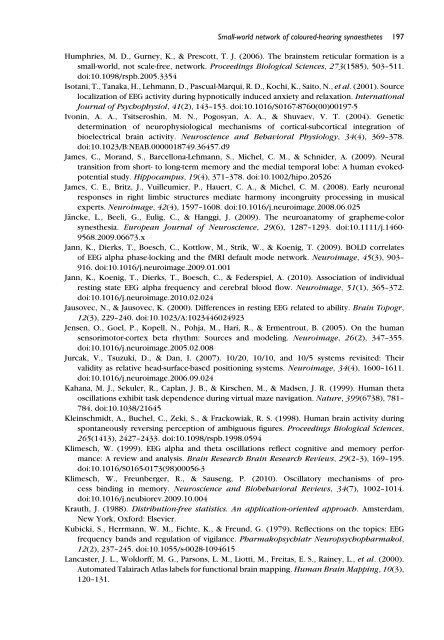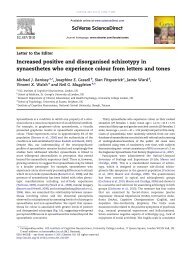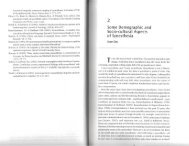A strong parietal hub in the small-world - Synesthesia
A strong parietal hub in the small-world - Synesthesia
A strong parietal hub in the small-world - Synesthesia
Create successful ePaper yourself
Turn your PDF publications into a flip-book with our unique Google optimized e-Paper software.
Small-<strong>world</strong> network of coloured-hear<strong>in</strong>g synaes<strong>the</strong>tes 197<br />
Humphries, M. D., Gurney, K., & Prescott, T. J. (2006). The bra<strong>in</strong>stem reticular formation is a<br />
<strong>small</strong>-<strong>world</strong>, not scale-free, network. Proceed<strong>in</strong>gs Biological Sciences, 273(1585), 503–511.<br />
doi:10.1098/rspb.2005.3354<br />
Isotani, T., Tanaka, H., Lehmann, D., Pascual-Marqui, R. D., Kochi, K., Saito, N., et al. (2001). Source<br />
localization of EEG activity dur<strong>in</strong>g hypnotically <strong>in</strong>duced anxiety and relaxation. International<br />
Journal of Psychophysiol, 41(2), 143–153. doi:10.1016/S0167-8760(00)00197-5<br />
Ivon<strong>in</strong>, A. A., Tsitserosh<strong>in</strong>, M. N., Pogosyan, A. A., & Shuvaev, V. T. (2004). Genetic<br />
determ<strong>in</strong>ation of neurophysiological mechanisms of cortical-subcortical <strong>in</strong>tegration of<br />
bioelectrical bra<strong>in</strong> activity. Neuroscience and Behavioral Physiology, 34(4), 369–378.<br />
doi:10.1023/B:NEAB.0000018749.36457.d9<br />
James, C., Morand, S., Barcellona-Lehmann, S., Michel, C. M., & Schnider, A. (2009). Neural<br />
transition from short- to long-term memory and <strong>the</strong> medial temporal lobe: A human evokedpotential<br />
study. Hippocampus, 19(4), 371–378. doi:10.1002/hipo.20526<br />
James, C. E., Britz, J., Vuilleumier, P., Hauert, C. A., & Michel, C. M. (2008). Early neuronal<br />
responses <strong>in</strong> right limbic structures mediate harmony <strong>in</strong>congruity process<strong>in</strong>g <strong>in</strong> musical<br />
experts. Neuroimage, 42(4), 1597–1608. doi:10.1016/j.neuroimage.2008.06.025<br />
Jäncke, L., Beeli, G., Eulig, C., & Hanggi, J. (2009). The neuroanatomy of grapheme-color<br />
synes<strong>the</strong>sia. European Journal of Neuroscience, 29(6), 1287–1293. doi:10.1111/j.1460-<br />
9568.2009.06673.x<br />
Jann, K., Dierks, T., Boesch, C., Kottlow, M., Strik, W., & Koenig, T. (2009). BOLD correlates<br />
of EEG alpha phase-lock<strong>in</strong>g and <strong>the</strong> fMRI default mode network. Neuroimage, 45(3), 903–<br />
916. doi:10.1016/j.neuroimage.2009.01.001<br />
Jann, K., Koenig, T., Dierks, T., Boesch, C., & Federspiel, A. (2010). Association of <strong>in</strong>dividual<br />
rest<strong>in</strong>g state EEG alpha frequency and cerebral blood flow. Neuroimage, 51(1), 365–372.<br />
doi:10.1016/j.neuroimage.2010.02.024<br />
Jausovec, N., & Jausovec, K. (2000). Differences <strong>in</strong> rest<strong>in</strong>g EEG related to ability. Bra<strong>in</strong> Topogr,<br />
12(3), 229–240. doi:10.1023/A:1023446024923<br />
Jensen, O., Goel, P., Kopell, N., Pohja, M., Hari, R., & Ermentrout, B. (2005). On <strong>the</strong> human<br />
sensorimotor-cortex beta rhythm: Sources and model<strong>in</strong>g. Neuroimage, 26(2), 347–355.<br />
doi:10.1016/j.neuroimage.2005.02.008<br />
Jurcak, V., Tsuzuki, D., & Dan, I. (2007). 10/20, 10/10, and 10/5 systems revisited: Their<br />
validity as relative head-surface-based position<strong>in</strong>g systems. Neuroimage, 34(4), 1600–1611.<br />
doi:10.1016/j.neuroimage.2006.09.024<br />
Kahana, M. J., Sekuler, R., Caplan, J. B., & Kirschen, M., & Madsen, J. R. (1999). Human <strong>the</strong>ta<br />
oscillations exhibit task dependence dur<strong>in</strong>g virtual maze navigation. Nature, 399(6738), 781–<br />
784. doi:10.1038/21645<br />
Kle<strong>in</strong>schmidt, A., Buchel, C., Zeki, S., & Frackowiak, R. S. (1998). Human bra<strong>in</strong> activity dur<strong>in</strong>g<br />
spontaneously revers<strong>in</strong>g perception of ambiguous figures. Proceed<strong>in</strong>gs Biological Sciences,<br />
265(1413), 2427–2433. doi:10.1098/rspb.1998.0594<br />
Klimesch, W. (1999). EEG alpha and <strong>the</strong>ta oscillations reflect cognitive and memory performance:<br />
A review and analysis. Bra<strong>in</strong> Research Bra<strong>in</strong> Research Reviews, 29(2–3), 169–195.<br />
doi:10.1016/S0165-0173(98)00056-3<br />
Klimesch, W., Freunberger, R., & Sauseng, P. (2010). Oscillatory mechanisms of process<br />
b<strong>in</strong>d<strong>in</strong>g <strong>in</strong> memory. Neuroscience and Biobehavioral Reviews, 34(7), 1002–1014.<br />
doi:10.1016/j.neubiorev.2009.10.004<br />
Krauth, J. (1988). Distribution-free statistics. An application-oriented approach. Amsterdam,<br />
New York, Oxford: Elsevier.<br />
Kubicki, S., Herrmann, W. M., Fichte, K., & Freund, G. (1979). Reflections on <strong>the</strong> topics: EEG<br />
frequency bands and regulation of vigilance. Pharmakopsychiatr Neuropsychopharmakol,<br />
12(2), 237–245. doi:10.1055/s-0028-1094615<br />
Lancaster, J. L., Woldorff, M. G., Parsons, L. M., Liotti, M., Freitas, E. S., Ra<strong>in</strong>ey, L., et al. (2000).<br />
Automated Talairach Atlas labels for functional bra<strong>in</strong> mapp<strong>in</strong>g. Human Bra<strong>in</strong> Mapp<strong>in</strong>g, 10(3),<br />
120–131.




